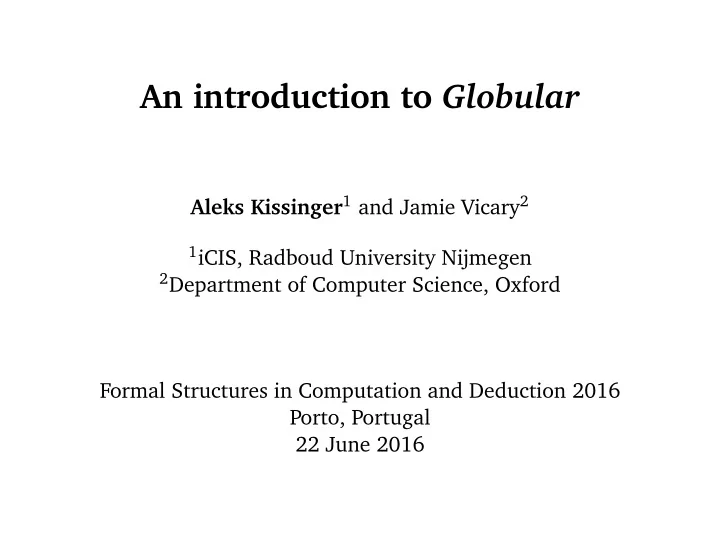

An introduction to Globular Aleks Kissinger 1 and Jamie Vicary 2 1 iCIS, Radboud University Nijmegen 2 Department of Computer Science, Oxford Formal Structures in Computation and Deduction 2016 Porto, Portugal 22 June 2016
Introduction Globular is a web-based proof assistant for higher category theory. It has many features making it practically useful: ◮ It’s a webpage; nothing to download. ◮ Graphical point-and-click interface. ◮ Graphical presentation of morphisms/proofs using string diagrams . ◮ Fully formal; it won’t let you make a mistake. ◮ Download images for inclusion in your paper. ◮ Link from your paper directly to the formal online proof. ◮ Share projects privately with collaborators. ◮ Use existing proofs as lemmas in new proofs. It’s available now at http://globular.science.
Higher categories Higher-dimensional categories have morphisms between morphisms . g A B α f Examples: categories, functors, and natural transformations; points, paths, and homotopies; algebraic/coalgebraic theories; freely presented ( n -)categories; ...
Graphical notation Here is a diagram in the 2d graphical notation: B s s C A E t t D F 0-morphisms (objects): regions 1-morphisms : wires 2-morphisms : nodes It is dual to the traditional ‘pasting diagram’ notation. Subsumes string diagram notation for monoidal categories (1 object case).
Graphical notation Extends to higher dimensions, e.g. in 3d: β α 0-morphisms (objects): volumes 1-morphisms : regions 2-morphisms : wires 3-morphisms : nodes
Paradigm: proofs-as-diagrams Proofs about n -morphisms are diagrams of n + 1 morphisms: assoc assoc assoc Benefit: Proofs can be viewed and transformed (e.g. refactored, simplified) just like any other diagram!
Formalism: semistrict categories The n -categories we use are semistrict . This means: ( f ◦ g ) ◦ h = f ◦ ( g ◦ h ) f ◦ 1 = f = 1 ◦ f but: ( f ◦ 1 1 B ) ◦ 2 ( 1 A ′ ◦ 1 g ) → ← ( 1 A ◦ 1 g ) ◦ 2 ( f ◦ 1 1 B ′ ) → ←
Geometry of interchangers One dimension higher, interchangers look like crossings: ...and coherence (e.g. invertibility, naturality) makes them act like crossings: → → ← ←
Time to get Globulizing!
Thanks! These guys did most of the hard stuff... :) Jamie Vicary Krzysztof Bar Caspar Wylie http://globular.science
Recommend
More recommend